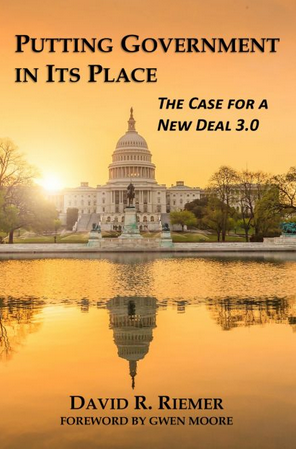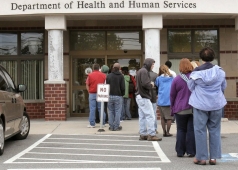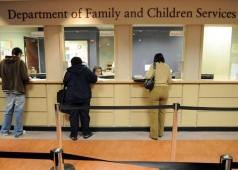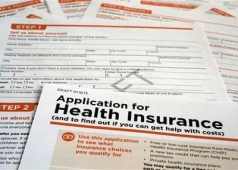Delivering Security
We've made progress since the "old days" when Americans were obliged to appear in person at government offices--often waiting in long lines, standing in front of glassed-in counters, and filling out lengthy paper forms--to apply for each separate economic security program.
Still, government is miles away from having in place an optimal system for (1) informing people about available programs, (2) signing them up, (3) explaining their benefits and options, and (4) helping them to make decisions.
Today's delivery system for economic security remains bizarrely complex, structurally disjointed, technologically ancient, and user-hostile. The American people pay a boatload of taxes to finance economic security. Just as we deserve security policies that are not riddled with holes and defects, we deserve a delivery system that is simple, transparent, joined-up, high-tech, easy to navigate, and above all empowering.
Step One: Simplify Economic Security Itself
The first essential step is to dramatically simplify the economic security system itself. This can be achieved--as proposed here--by:
- Sharply reducing, through consolidation, the sheer number of economic security programs, including those that provide equal opportunity in health care and education;
- Eliminating all poverty-requiring, "means-tested" welfare programs.
We do not need dozens of programs to provide Transitional Jobs to the unemployed and underemployed, enforce a higher minimum wage, provide workers with a larger and better earnings supplement, and boost the income of impoverished adults with disabilities or who have retired.
In the area of equal opportunity, we do need multiple programs to guarantee excellent health insurance to all Americans, or to provide good child care and a good education to the nation's children.
A dozen programs--a score at most--should suffice.
If we put these programs in place, we can simultaneously eliminate a long list of poverty-requiring welfare programs.
It will be dramatically simpler to operate a delivery system that delivers the 12-20 big economic security and equal opportunity programs the nation needs, rather than the 50+ programs we now have.
Step Two: Revolutionize the Delivery System
Then, on top of this simplification in policy, today's amazing web-based technology (as well as Americans' growing confidence in using it) provides an opportunity to revolutionize the way Americans experience economic security and equal opportunity
If we set our minds to it, we could easily put in place a simple, understandable, unified, tech-driven, user-friendly, empowering delivery system that:
- Makes it crystal clear to all Americans what programs, tools and choices they have;
- Automatically enrolls them and disenrolls them;
- Enables them to easily make decisions.
Individual Progress Portfolio
The easiest approach would be to provide every American, at birth (or upon naturalization), an Individual Progress Portfolio.
The Portfolio would have four separate accounts (several of which have previously been mentioned):
- A Health Insurance Purchasing Account
- A Child Care and Education Account
- An Employment and Income Account
- A Retirement Account
Parents (or guardians) would control their children's Portfolios until age 18. After that, the owner of the Portfolio--the new adult--would take over.
Each Portfolio account would provide a specific dollar amount to be used for the account's named purpose:
- Buying health insurance: Parents would direct the actuarially adjusted amount in the Health Insurance Purchasing Account, on their children's behalf, to the parents' preference among a wide range of excellent health care plans and providers. At age 18, individuals would begin to make their own health care plan selections. At age 65, seniors who qualify for Medicare would decide, as they now do, whether to enroll in a Medicare HMO or a Medicare fee-for-service plan.
- Paying for child care and education: Parents who want child care for their 0-4 year olds would direct the amount in the Child Care and Education Account, on behalf of their children, to the parents' choice of a carefully vetted child care provider. Parents would proceed to use the account to place their 4-to-17 year old children in the parents' choice of an excellent K12 school that has satisfied rigorous public standards. Older students, at age 18, would then take over their accounts. If they wish to attend college--and qualify--they would use the account to enroll and continue for up to four years in the students' choice of higher education.
- Obtaining a job and maintaining a decent living standard: Adults 18 and older would use their Employment and Income Accounts to obtain any Unemployment Insurance benefits that they qualify for, or apply for a Transitional Job. Once working, they would use the account to receive an earnings supplement. If unable to work, they would use the account to apply for and (if they qualify) receive a disability benefit.
- Receiving retirement benefits: Finally, adults 62 and older would use their Retirement Accounts to apply for and receive their Social Security pension benefits.
For more detail on how the Individual Progress Portfolio would work, and to see an illustration of its operation: Read More ->
Why Change?
The details for how the Individual Progress Portfolio would work are important. But what matters most is the concept, and the advantages it offers.
Americans would be freed from the mind-numbing complexity inflicted on them by 50+ separate programs--each with its own complex rules, and many that trap the least fortunate in a poverty-requiring welfare prison.
We would be freed as well from today's hostile delivery system, which continues to rely heavily on burdensome personal appearances in government offices, antiquated paperwork, and duplicative entry (and re-entry, and re-entry) of information on the separate forms required by disconnected programs.
Instead, through a single user-friendly program, every American would have instant access to a small number of economic security and equal opportunity programs that enable them to obtain the work, income, health care they need...and the health insurance, child care, and education their children need.
Because of the Individual Progress Portfolio's simple design and high-tech features, it will put Americans in the know--and in the driver's seat--as we navigate through what FDR called the "hazards and vicissitudes of life"...and help our children grow up healthy, get an education, and launch their own ventures.



